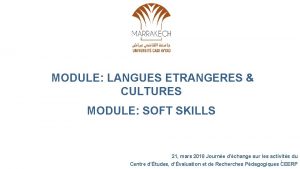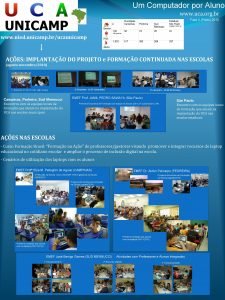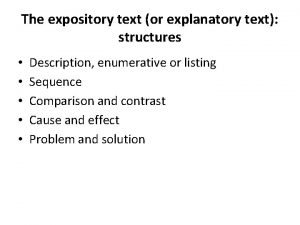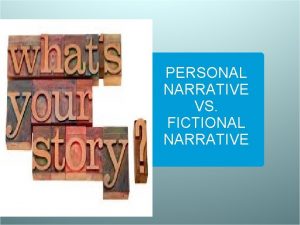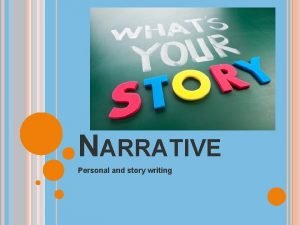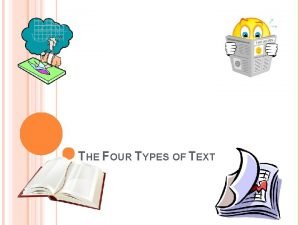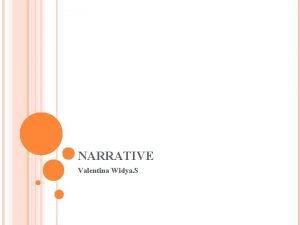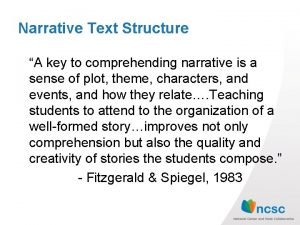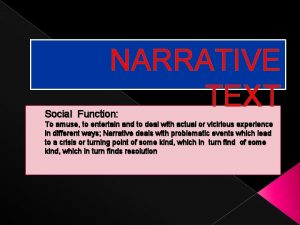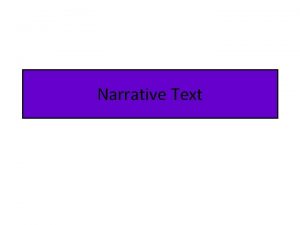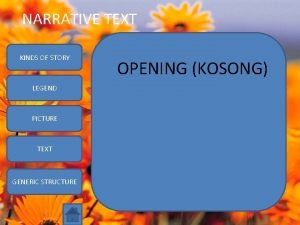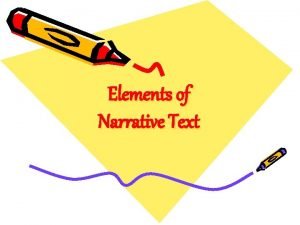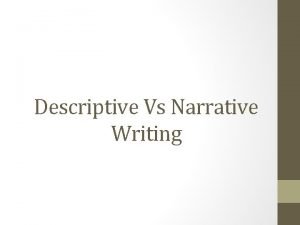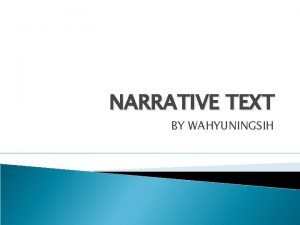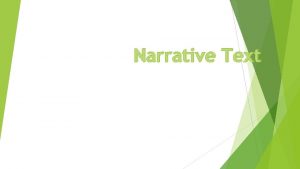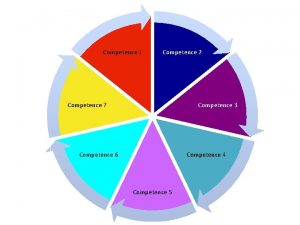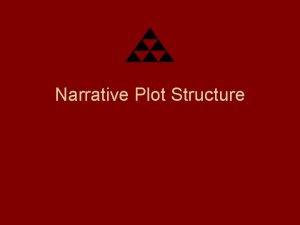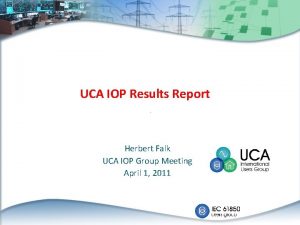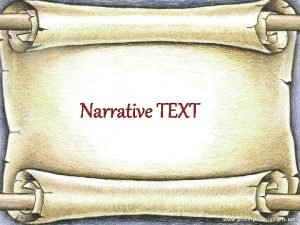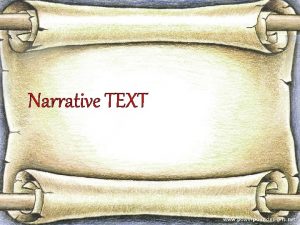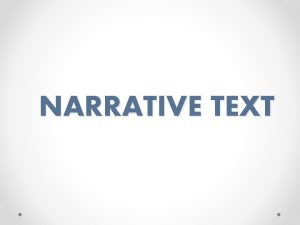NARRATIVE TEXT Uca Dahniar Ardiantin 2201409102 Standard Competence































- Slides: 31

NARRATIVE TEXT Uca Dahniar Ardiantin 2201409102

Standard Competence Writing 12. Mengungkapkan makna dalam teks tulis fungsional dan esei pendek sangat sederhana berbentuk narrative dan report untuk berinteraksi dalam kehidupan sehari – hari. konteks

Basic Competence 12. 2. Mengungkapkan makna dan langkah retorika dalam esei pendek sangat sederhana dengan menggunakan ragam bahasa tulis secara akurat, lancar dan berterima untuk berinteraksi dalam konteks kehidupan sehari - hari dalam teks berbentuk narrative.

Objectives of the Lesson: • 75% of all students are able to understand the content of narrative and answer correctly 3 of 4 the questions related to the text given. • 75% of all students are able to understand the purpose, the generic structure, and the lexicogrammatical feature of narrative text by correctly identify 3 of 5 narrative texts. • 75% of all students are able to write narrative.

Listen Carefully!

NARRATIVE TEXT • What is narrative text? • Social function • Generic structure • Lexicogrammatical features

GRAMMAR simple past tense Positive : S + V 2 Negative: S + did not + V 1 Question: Did + S + V 1 ?

Questions Who are the main characters involved in the story? What is the purpose of the text? When did the story happen? Where did the story happen? The Smartest Parrot Orientation Once upon time, a man had a wonderful parrot. There was no other parrot like it.

The parrot could say every word, except one word. The parrot would not say the name of the place where it was born “Catano”.

Complication The man felt excited having the smartest parrot but he could not understand why the parrot would not say Catano. The man tried to teach the bird to say Catano.

At the first, the man was very nice to the bird but then he got very angry. “You stupid bird!” pointed the man to the parrot. “Why can’t you say the word? Say Catano! Or I will kill you” the man said angrily.

Although he tried hard to teach, the parrot would not say it. Then the man got so angry and shouted to the bird over and over; “Say Catano or I’ll kill you”. The bird kept not to say the word of Catano.

One day, after he had been trying so many times to make the bird say Catano, the man really got very angry. He could not bear it. He picked the parrot and threw it into the chicken house.

There were four old chickens for next dinner “You are as stupid as the chickens. Just stay with them” Said the man angrily. Then he continued to humble; “You know, I will cut the chicken for my meal.

Next it will be your turn, I will eat you too, stupid parrot”. After that he left the chicken house. Resolution The next day, the man came back to the chicken house.

He opened the door and was very surprised. There were three death chickens on the floor. At the moment, the parrot was standing proudly and screaming at the last old chicken; “Say Catano or I’ll kill you”.

Questions 1. Who are the main characters involved in the story? 2. What is the purpose of the text? 3. When did the story happen? 4. Where did the story happen?

Arrange These Paragraph in Order! The Bear and The Rabbit q Once upon a time, there lived a bear and a rabbit. The rabbit is a good shot. In contrary, the bear is always clumsy and could not use the arrow.

q However the bear did not want the rabbit to get any of the meat. The rabbit could not even taste the meat. The poor rabbit would have to go home hungry after his hard day's work. q The bear was the father of five children. Fortunately, the youngest child was very kind to the rabbit. The mother bear always gave

him an extra large piece of meat but the youngest child did not eat it. He kicked the meat toward the rabbit's house. In this way, the poor rabbit would get his meal. q He went with the bear and shot enough buffalo to satisfy the hungry family. Indeed he shot and killed so many that there were lots of meats left.

q One day, the bear called over the rabbit and asked the rabbit to take his bow and arrows.

The Story of Cinderella

Read and Analyze the Generic Structure of this Text! Cinderella Once upon a time there was a girl called Cinderella. She lived with her stepsisters. They were very bossy. They made Cinderella do all the housework.

One day an invitation to the ball came to the family. Her stepsisters would not let her go. Cinderella was sad because she wanted to go to the ball too. Her stepsisters went to the ball without her.

Fortunately, the fairy Godmother came and helped her to get to the ball. At the ball, Cinderella dance with the prince. The prince fell in love with her then married her. They lived happily ever after.

Fun Learning Activity! was 1. There (is) lived a girl called Cinderella. 2. She (live) were with her stepsisters. 3. They (are) made very bossy. 4. They (make) Cinderella do all the housework. 5. One day an invitation to the ball (come) to the family. came

Was sad 6. Cinderella (is sad) because she wanted to go to the ball too. went 7. Her stepsisters (go) to the ball without her. 8. The fairy Godmother (come and help) her to get to the Came and helped ball. 9. The prince (fall) in love with her then married her. fell 10. They (live) happily ever after. lived

What is narrative text? Narrative text is a text which contains about story and its plot consists of climax of the story then followed by the resolution

Social function To amuse, entertain, and do deal with actual or vicarious experience in different ways

Generic structure Orientation Introducing the participants and informing the time and the place Complication Describing the rising crises which the participants have to do with Resolution Showing the way of participant to solve the crises, better or worse

Lexicogrammatical features Focus on specific and usually individualized participants Use of material processes Use of temporal conjunctions, and temporal circumstances Use of relational processes and mental processes Use of past tense
 What is an example of a text-to-media connection?
What is an example of a text-to-media connection? Uca prepaid training
Uca prepaid training Uca academic probation
Uca academic probation Uca dnp program
Uca dnp program Inscription administrative uca
Inscription administrative uca Soft skills uca
Soft skills uca Www.uca
Www.uca Torreyson apartments uca
Torreyson apartments uca Uca college of business
Uca college of business Bernard hall uca
Bernard hall uca Gade uca
Gade uca Narrative vs expository text
Narrative vs expository text Narrative vs expository text
Narrative vs expository text Fictional narrative story
Fictional narrative story Narrative vs story
Narrative vs story Standard error
Standard error Standard language meaning
Standard language meaning Define standard cost and standard costing
Define standard cost and standard costing Tahap berkefungsian mbk
Tahap berkefungsian mbk Narrative text example
Narrative text example Narrative text is
Narrative text is Climax of the princess and the pea
Climax of the princess and the pea Parts of a narrative
Parts of a narrative The social function of the story is
The social function of the story is What are the structures narrative text? *
What are the structures narrative text? * Social function of narrative text legend
Social function of narrative text legend Main purpose of narrative writing
Main purpose of narrative writing Legend narrative
Legend narrative Narrative text element
Narrative text element Descriptive vs narrative writing
Descriptive vs narrative writing Mouse deer and crocodile orientation
Mouse deer and crocodile orientation A mama ostrich returned home from
A mama ostrich returned home from





